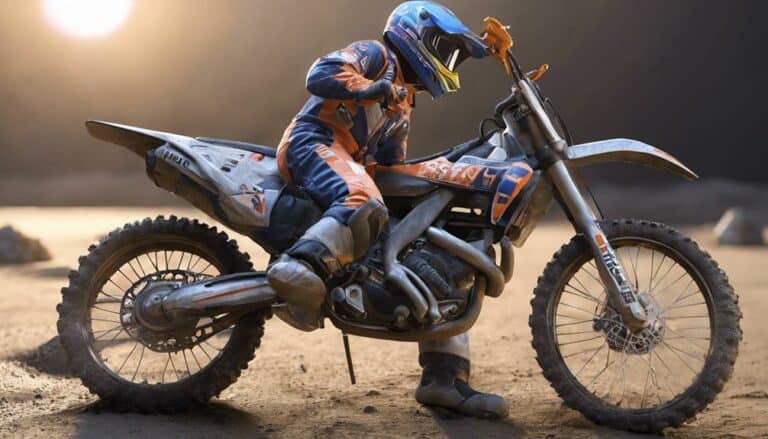You should check your dirt bike's cooling system before every ride. Inspect coolant levels and components like the water pump, hoses, and radiator for leaks or damage. Conduct a thorough check every 3-6 months for best performance. Stay proactive to avoid expensive repairs. Regular maintenance is key to prevent overheating and maintain peak engine performance. By monitoring coolant levels, watching for leaks, and listening for unusual noises, you can detect issues early. Consistent inspections help identify problems before they escalate. Your cooling system's health is essential for your bike's longevity and efficiency.
Key Takeaways
- Visually inspect cooling system before each ride to catch issues early.
- Check coolant levels regularly to ensure optimal performance.
- Perform a thorough inspection every 3-6 months for maintenance.
- Watch for coolant leaks, overheating, and unusual noises as warning signs.
- Stay proactive to avoid costly repairs and maintain peak engine performance.
Frequency of Cooling System Checks
How frequently should you visually inspect your dirt bike's cooling system before each ride?
Regularly checking your dirt bike's cooling system is essential for proper maintenance and peak performance. Start by examining the coolant levels to make sure they're at the recommended level for efficient cooling. Inspect the water pump, hoses, and radiator for any visible leaks, damage, or debris that could impede the system's function. By performing these visual checks before each ride, you can catch any potential issues early on and prevent more significant problems down the road.
Additionally, consider a more thorough inspection every 3-6 months, depending on how often you use your dirt bike. This in-depth check can help identify any underlying issues that may not be apparent during routine inspections. By staying proactive with your cooling system checks, you can avoid costly repairs and ensure your dirt bike operates at its best.
Signs of Cooling System Issues
To detect potential cooling system issues in your dirt bike, watch for signs such as coolant leaks, overheating, abnormal temperature gauge readings, unusual noises, and fluctuations in coolant levels.
Coolant leaks or puddles under the bike can indicate a problem within the cooling system, potentially stemming from a leaky hose or a damaged radiator. Overheating during rides is another red flag that suggests issues with the radiator or low coolant levels.
Keeping an eye on the temperature gauge for sudden spikes or fluctuations while riding can help identify cooling system problems early on. Unusual noises like bubbling or gurgling may signal the presence of air pockets in the system, hindering proper coolant circulation.
Regularly monitoring the coolant level in both the radiator and reservoir is vital to guarantee the cooling system functions optimally and to address any potential problems promptly. Stay vigilant for these signs to maintain your dirt bike's cooling system in top-notch condition.
Importance of Regular Maintenance
Consistently maintaining your dirt bike's cooling system is vital for peak engine performance and longevity. Your engine relies on the cooling system to regulate temperature and prevent overheating, which can lead to serious damage.
By regularly checking the fluid levels in the radiator and ensuring its health, you can help your dirt bike run smoothly and efficiently. Proper maintenance not only safeguards your engine but also improves overall performance. Neglecting the cooling system can result in decreased power output and potential breakdowns, impacting your riding experience and requiring costly repairs.
Regular inspections of the cooling system, including the radiator and other components, are essential to identify any issues early on. By following a maintenance schedule and conducting checks before and after each ride, you can prolong the life of your dirt bike and save time and money in the long run.
Investing time in caring for your cooling system will pay off with improved engine performance and reliability on the trails.
DIY Cooling System Inspection Tips
Regularly performing a visual inspection of your dirt bike's cooling system before each ride is crucial for guaranteeing excellent performance and preventing potential issues. To conduct a thorough DIY cooling system inspection, follow these tips:
- Check the Radiator: Look for any debris blocking the radiator fins, which can hinder airflow and lead to overheating. Ensure there are no visible signs of leaks around the radiator.
- Inspect Hoses and Clamps: Examine all hoses and clamps for any signs of wear, cracks, or leaks. Tighten any loose clamps to prevent coolant leakage during rides.
- Monitor Coolant Levels: Verify the coolant levels in the radiator and reservoir regularly. Top up the coolant if the levels are low, and look for any discoloration or unusual odors in the coolant, which could indicate a problem within the cooling system.
Professional Cooling System Evaluation
When seeking professional cooling system evaluation for your dirt bike, an annual inspection by a certified mechanic is highly recommended. A mechanic will thoroughly check the radiator, hoses, water pump, and coolant levels to make sure everything is in peak condition.
Professional inspections can detect leaks, blockages, or signs of wear and tear early on, preventing potential issues from escalating. Mechanics are equipped to perform pressure tests and visual inspections to provide a thorough assessment of your cooling system's health.
Conclusion
To summarize, it's advised to inspect your dirt bike's cooling system every 20-30 hours of riding to guarantee peak performance. Neglecting signs of cooling system issues can result in expensive repairs and potential engine damage.
Remember, proper maintenance is crucial to keeping your dirt bike running smoothly. Did you know that 90% of cooling system failures are caused by lack of maintenance? Stay ahead of the game and keep your bike in top-notch condition.

